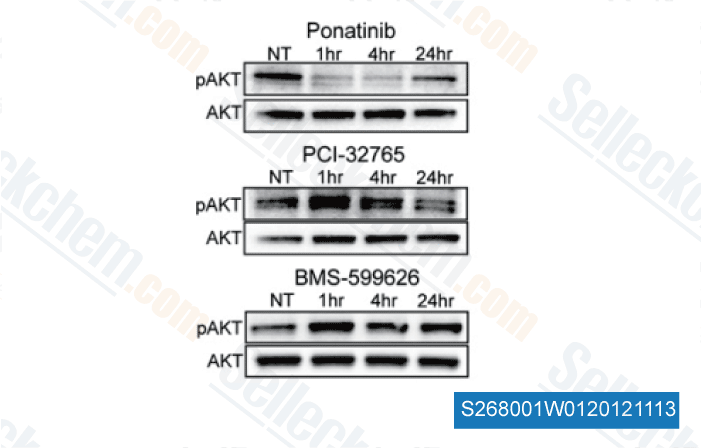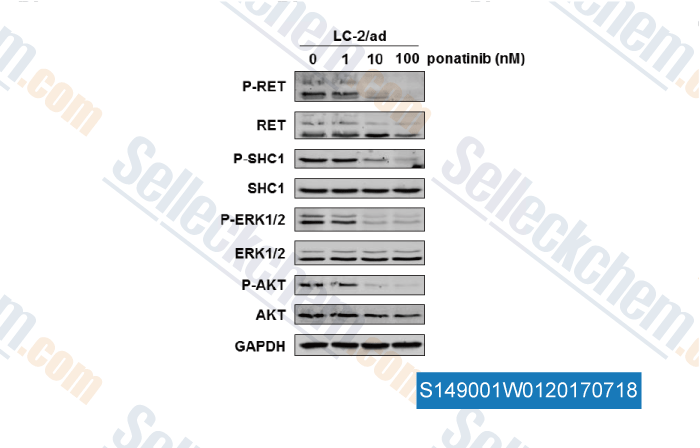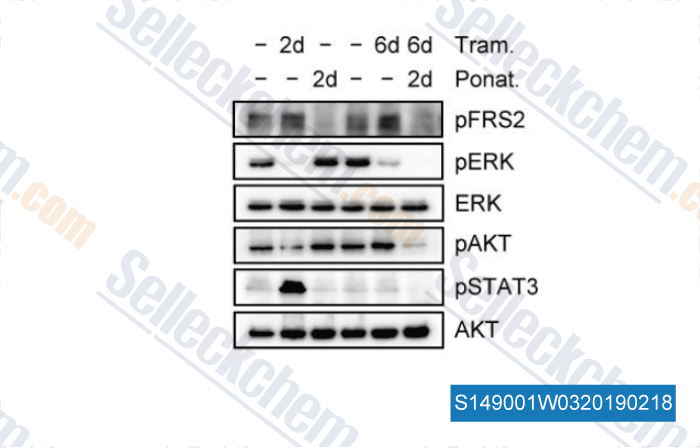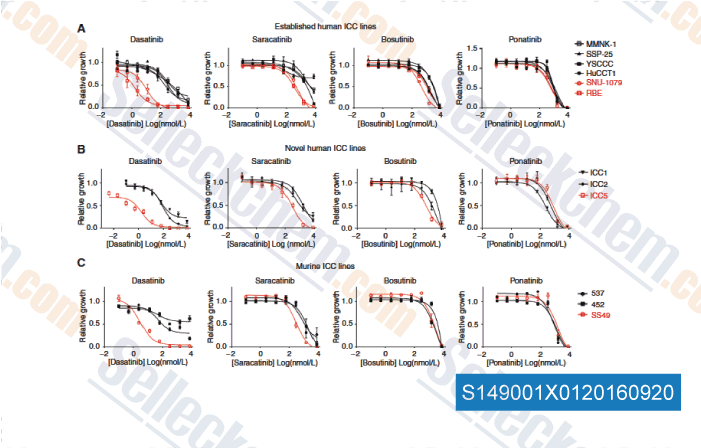|
Toll Free: (877) 796-6397 -- USA and Canada only -- |
Fax: +1-832-582-8590 Orders: +1-832-582-8158 |
Tech Support: +1-832-582-8158 Ext:3 Please provide your Order Number in the email. |
Technical Data
| Formula | C29H27F3N6O |
|||
| Molecular Weight | 532.56 | CAS No. | 943319-70-8 | |
| Solubility (25°C)* | In vitro | DMSO | 100 mg/mL (187.77 mM) | |
| Water | Insoluble | |||
| Ethanol | Insoluble | |||
|
* <1 mg/ml means slightly soluble or insoluble. * Please note that Selleck tests the solubility of all compounds in-house, and the actual solubility may differ slightly from published values. This is normal and is due to slight batch-to-batch variations. * Room temperature shipping (Stability testing shows this product can be shipped without any cooling measures.) |
||||
Preparing Stock Solutions
Biological Activity
| Description | Ponatinib is a novel, potent multi-target inhibitor of Abl, PDGFRα, VEGFR2, FGFR1 and Src with IC50 of 0.37 nM, 1.1 nM, 1.5 nM, 2.2 nM and 5.4 nM in cell-free assays, respectively. Ponatinib (AP24534) inhibits autophagy. | |||||||||||
|---|---|---|---|---|---|---|---|---|---|---|---|---|
| Targets |
|
|||||||||||
| In vitro | AP24534 potently inhibits native Abl, AblT315I, and other clinically important Abl kinase domain mutants with IC50 of 0.30 nM–2 nM. AP24534 doesn't inhibit Aurora kinase family members, nor does it inhibit insulin receptor or CDK2/cyclin E. AP24534 inhibits proliferation of Ba/F3 cells expressing Bcr-Abl with IC50 of 0.5 nM, as well as Ba/F3 cells expressing a range of Bcr-Abl mutants with IC50 of 0.5 nM–36 nM. The inhibition of proliferation by AP24534 is correlated with induction of apoptosis. [1-2] In leukemic cell lines containing activated forms of FLT3, KIT, FGFR1, and PDGFRα receptors, AP24534 potently inhibits receptor phosphorylation and cellular proliferation with IC50 of 0.3 nM to 20 nM. In MV4-11 (FLT3-ITD(+/+)) but not RS4;11 (FLT3-ITD(–/–)) AML cells, AP24534 inhibits FLT3 signaling and induced apoptosis at less than 10 nM. AP24534 inhibits viability of primary leukemic blasts from a FLT3-ITD positive AML patient with IC50 of 4 nM but not those from patients with AML expressing native FLT3. [3] In Ba/F3 cells engineered to express activated FGFR1-4, AP24534 potently inhibits FGFR-mediated signaling and viability with IC50 lower than 40 nM. In cell lines representing multiple tumor types (endometrial, bladder, gastric, breast, lung, and colon), and containing FGFRs dysregulated by a variety of mechanisms, AP24534 inhibits FGFR-mediated signaling with IC50 less than 40 nM and inhibits cell growth with IC50 of 7 nM–181 nM. [4] | |||||||||||
| In vivo | In a mouse xenograft model of Ba/F3 cells expressing native Bcr-Abl, AP24534 (2.5 mg/kg and 5 mg/kg) prolongs mice median survival. In the xenograft model of Ba/F3 Bcr-AblT315I, AP24534 (10 mg/kg–50 mg/kg) significantly suppresses tumor growth. AP24534 (30 mg/kg) decreases the phosphorylated Bcr-Abl and phosphorylated CrkL levels in the tumors. [2] |
Protocol (from reference)
| Kinase Assay:[1] |
|
|---|---|
| Cell Assay:[2] |
|
| Animal Study:[1] |
|
References
Customer Product Validation

-
Data from [Cancer Cell, 2012, 22(5), 656-667 ]

-
, , Mol Cancer Ther, 2017, 16(8):1623-1633

-
Data from [Data independently produced by , , Nature, 2016, 534(7609):647-51]

-
Data from [Data independently produced by , , Cancer Discov, 2016, 6(7):727-39.]
Selleck's Ponatinib has been cited by 218 publications
| Leishmania braziliensis enhances monocyte responses to promote anti-tumor activity [ Cell Rep, 2024, 43(3):113932] | PubMed: 38457336 |
| The molecular basis of Abelson kinase regulation by its αI-helix [ Elife, 2024, 12RP92324] | PubMed: 38588001 |
| Asciminib Maintains Antibody-Dependent Cellular Cytotoxicity against Leukemic Blasts [ Cancers (Basel), 2024, 16(7)1288] | PubMed: 38610966 |
| The Combination of Afatinib With Dasatinib or Miransertib Results in Synergistic Growth Inhibition of Stomach Cancer Cells [ World J Oncol, 2024, 15(2):192-208] | PubMed: 38545471 |
| Targeting FLT3-TAZ signaling to suppress drug resistance in blast phase chronic myeloid leukemia [ Mol Cancer, 2023, 10.1186/s12943-023-01837-4] | PubMed: 37932786 |
| Dual Targeting of Apoptotic and Signaling Pathways in T-Lineage Acute Lymphoblastic Leukemia [ Clin Cancer Res, 2023, 29(16):3151-3161] | PubMed: 37363966 |
| A GSTP1-mediated lactic acid signaling promotes tumorigenesis through the PPP oxidative branch [ Cell Death Dis, 2023, 14(7):463] | PubMed: 37491277 |
| A GSTP1-mediated lactic acid signaling promotes tumorigenesis through the PPP oxidative branch [ Cell Death Dis, 2023, 14(7):463] | PubMed: 37491277 |
| Dual Targeting of Apoptotic and Signaling Pathways in T-Lineage Acute Lymphoblastic Leukemia [ Clin Cancer Res, 2023, 29(16):3151-3161] | PubMed: 37363966 |
| Promoter swapping of truncated PDGFRB drives Ph-like acute lymphoblastic leukemia [ NPJ Precis Oncol, 2023, 7(1):132] | PubMed: 38071343 |
RETURN POLICY
Selleck Chemical’s Unconditional Return Policy ensures a smooth online shopping experience for our customers. If you are in any way unsatisfied with your purchase, you may return any item(s) within 7 days of receiving it. In the event of product quality issues, either protocol related or product related problems, you may return any item(s) within 365 days from the original purchase date. Please follow the instructions below when returning products.
SHIPPING AND STORAGE
Selleck products are transported at room temperature. If you receive the product at room temperature, please rest assured, the Selleck Quality Inspection Department has conducted experiments to verify that the normal temperature placement of one month will not affect the biological activity of powder products. After collecting, please store the product according to the requirements described in the datasheet. Most Selleck products are stable under the recommended conditions.
NOT FOR HUMAN, VETERINARY DIAGNOSTIC OR THERAPEUTIC USE.
